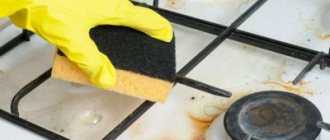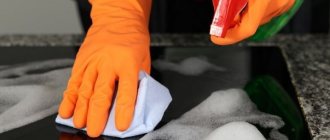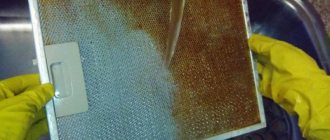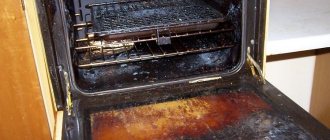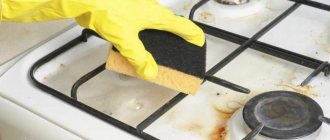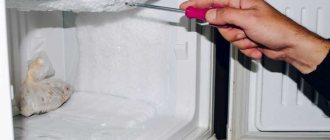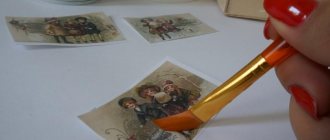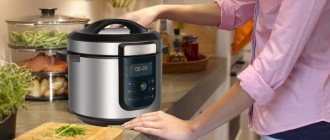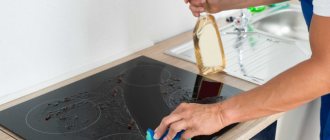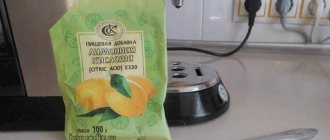Induction cookers look elegant in modern kitchen interiors. They do not take up much space, serve for a long time and without interruption, and do not require complex maintenance. But this does not mean that you can use any cleaning products or metal sponges on these surfaces. To keep glass-ceramic tiles safe and sound, it is important to follow the recommendations.
Rules of service
Induction panels quickly gained popularity among users not so much due to the properties of heat transfer without heating a larger surface area, but due to their stylish and laconic design.
Such hobs provide a smooth (and even mirror-like) surface. The material from which the boards are made can withstand impacts and high temperatures, but it is very easy to scratch (even accidentally). If a knife or fork falls on the stove, it will leave a mark on the surface. This must be taken into account when maintaining the unit.
WE RECOMMEND! Read on our website detailed instructions on how to clean the inside of the refrigerator after defrosting.
In order for glass-ceramic tiles to last for many years, you need to follow some recommendations:
- Wash the stove after it has cooled completely. Otherwise, in 100% of 100 cases, soap stains, remains of burnt food, drops and other dirt will remain on the stove. You can also easily get burned on such a surface.
- It's best to wipe down your stove before you start cooking. This may sound strange to some, since the surface is already clean. But there are already small stains on the tile, they will begin to burn and stick during work, and from small such stains will quickly turn into noticeable and difficult to remove.
- Carefully ensure the cleanliness and smoothness of the bottom of the dishes that you place on the tile. Rough, oily, uneven bottom may damage the surface.
- Make sure that there are no water droplets or streaks left on the stove after cleaning. Be sure to wipe the surface after washing with a paper towel or dry soft cloth.
- You should not use the same sponges or rags to clean your induction cooker that you, for example, use to wash dishes, wipe furniture or windows. Cleaning with such rags will leave stains and streaks.
Daily care
To ensure that your induction hob lasts longer and its appearance remains presentable, clean the surface daily.
IMPORTANT! Daily care includes normal damp cleaning with a suitable mild detergent and a clean sponge without any abrasives. After cleaning, wipe the surface dry with a cloth or paper towel.
Do you have an induction cooker?
Not really
Step by step cleaning:
- Wait for the hob to cool completely.
- Dampen a soft and clean (!) sponge in a soapy solution and wipe the surface of the tile.
- Leave the product on for a few minutes so that it has time to eat away any burnt-on food debris.
- Wipe the surface with a clean, damp cloth to remove any remaining soap, grease or scale.
- Dry with a paper or cloth towel.
Major cleaning
If you just can’t get rid of old stains on your induction hob, then regular wet cleaning will no longer work for you. Here you need to approach the problem radically. For major cleaning you will need rubber scrapers and specialized cleaning products for glass-ceramic surfaces (stoves) :
- Apply your regular detergent to the entire tile surface. Place a cloth soaked in detergent on especially problem areas. Leave everything for a few minutes.
- Wipe with a damp, clean cloth, and remove any remaining burnt food with a rubber scraper. At the same time, hold the spatula at an angle of 30-45 degrees so as not to scratch the panel.
- If the detergent cannot cope with the stains, then it’s time to move on to using specialized preparations that are designed for cleaning induction hobs. Typically, the instructions call for applying a small amount of the product to stains and carbon deposits for a few minutes, after which you need to remove the remaining solution and loose grease with a damp sponge or cloth.
ATTENTION! You can use specialized cleaning products for hobs only with gloves, as they contain aggressive chemical compounds that can corrode the skin.
General cleaning
Not everyone is able to care for the stove every day; as a result, the surface requires cleaning using more serious methods. To get rid of burnt food particles, you must first soak them. To do this, soak soft cloths in the detergent solution and place them on all problem areas. After a few minutes, the dirt will soften, and you can easily clean it off with a scraper (hold the scraper at an angle of 45 degrees to the surface). Finally, follow steps two and three from the previous section.
The scraper for induction cookers is equipped with a replaceable nozzle
If after such manipulations there are white spots on the glass panel, remove them with table vinegar. Soak a soft cloth in it, wring it out and walk over the whitened areas.
In a situation where caked-on deposits just don’t want to be cleaned off, sometimes you just want to use an aggressive cleaning agent for plumbing fixtures or tiles. Under no circumstances should this be done! Exposure to caustic chemicals can cause permanent damage to the slab surface. To remove “stubborn” dirt, re-place the cloth with the cleaning solution on it, but hold it a little longer, and then repeat the scrubbing.
The use of abrasive products can lead to this result
What rag to wash with
Only soft sponges or cloths without rough surfaces or texture can be used on induction hobs. You should not use metal sponges or scrapers, they will leave scratches on the surface and you will damage the hob. If you don’t have enough sponge to remove heavy carbon deposits, then use a rubber scraper (and then be careful).
What can be used
For safe cleaning we recommend:
- silicone or rubber scrapers;
- melamine sponge;
- “soft” gels and powders;
- paper towels;
- soft microfiber cloths.
Attention: what you are trying to clean your induction cooker with must be clean and not used for other household purposes.
What to do is strictly prohibited
Careless handling of the device may lead to damage. When operating and cleaning, you need to be as careful as possible and avoid the following actions:
- Do not clean the cooking surface with preparations containing abrasives. They will leave scratches that will significantly impair the performance of the tile in the future. The same applies to metal sponges, scrapers, knives and other sharp objects.
- Do not rub the surface if there are any hard particles left on it, for example, salt, sugar, etc. First, gently brush everything off or soak up any solid particles, only then proceed with the rest of the cleaning steps.
- Do not start cooking on the stove until you have removed any remaining food from it. Once the panel heats up, any residue will burn. It is very difficult to clean them when they are burnt.
- Do not expose the panel to sudden temperature changes. For example, you should not place objects from the refrigerator on it, splash ice water on it, scatter ice, etc.
How to clean various stains
IMPORTANT! In order for cleaning the hob to be as effective as possible, you need to take into account the type of contamination and its origin. Based on this data, we select a method for removing dirt.
From carbon deposits
Quite often, drops and pieces of food that are not wiped off the surface of the tile in a timely manner turn into soot. If you have started the problem, then you will no longer be able to do without a rubber scraper. You will have to soak the burnt residue for 10-40 minutes in detergent (or in a specialized cream for induction cookers), and then, after the carbon deposits have softened and come off a little, just carefully clean them with a scraper. At the end of the work, be sure to remove any remaining cleaning products and dirt with a damp sponge and wipe everything dry with a paper towel.
Read more about how to clean a ceramic hob from carbon deposits at home.
IMPORTANT! When using a rubber squeegee, always wet the surface before you begin scrubbing to avoid cracking or scratching the surface.
Fat
Regular dishwashing detergent is suitable for removing grease from the cooking surface. It dissolves fat perfectly.
However, it is better to entrust such contamination to specialized sprays, gels or cleaning creams for induction cooktops. They work much more efficiently and will not harm the hob.
How to clean the inside of the oven from grease, read this article.
Sugar
Sugar particles from the induction hob must be removed very carefully (this also applies to products that contain it):
- Cool the stove first.
- Use only silicone scrapers to avoid damaging the panel.
These two rules also apply to other low-melting materials such as polyethylene and plastic - they quickly melt on a hot surface, and then bake and stick tightly to it.
To remove sugar, you need to use major cleaning methods: specialized cleaning products, rubber scrapers, dishwashing detergents, etc.
Stains and plaque
Stains remain on the glossy and perfectly smooth surface of the tile. This is fine. But when these stains start and are not removed in time, they turn into a rather thick layer of plaque, which cannot be removed with ordinary wet daily cleaning.
IMPORTANT! Window cleaner is best for removing stains that appear after using tiles. These products contain chemical compounds that do not leave stains or streaks after drying.
Simply spray the surface of the tiles with the solution, then wait a while and wipe dry with a soft, clean cloth or paper towel.
Read here how to clean your kitchen hood from grease.
Recommended detergents
Before you go to the store, get the instructions for your stove and be sure to read the list of products that can be used for cleaning. Often the manufacturer even indicates specific names.
If the instructions are lost or there is no useful information in it, then you can enlist the experience of those who successfully keep their stove clean and tidy. So, take note of the following products - they can be found in stores and are not that expensive:
- Top House - often sold in a set with a scraper, blades and a special napkin (the set costs 600 rubles - quite affordable);
- Dr. Beckmann is an effective gel with a dispenser; it has a slightly chemical smell, but it does a great job even on old stains;
- Vitro Care - the manufacturer claims it is an environmentally friendly and safe product, removes stains with a bang and is quite economical in consumption.
But you should be careful with glass and mirror cleaning products. Of course, if you decide to use this method once, then nothing bad will happen. But if such care becomes systemic, there is a high risk of trouble in the future.
Folk remedies
It seems that there are a lot of popular methods to solve any problem. This also applies to cleaning the induction hob.
Vegetable oil
For cleaning, you can use vegetable oils (sunflower or olive):
- Apply a small amount of oil to a cloth and apply to the stain for 30 minutes.
- Wash the tiles with your regular detergent.
- Remove any remaining cleaning agent with a damp sponge.
- Wipe the panel dry with a paper towel.
How to clean with baking soda
Not the best option for cleaning an induction hob ( soda can leave scratches on the surface ). Use it only if you are absolutely confident in your abilities:
- Apply baking soda to the stained area.
- Cover the stain with a towel soaked in soapy water.
- Leave the baking soda and soap on the stain for 15-30 minutes.
- Carefully remove any remaining detergent with a damp cloth. But under no circumstances rub the surface!
- Wipe dry with a clean towel.
Baking soda is widely used for cleaning household appliances. In this article you can learn simple recipes for cleaning the oven with soda and vinegar.
Removing scratches
Small scratches can very easily appear on the hob. They are clearly visible in the light and can spoil the appearance of the slab. If the scratches are not very deep, you can try to get rid of them. To do this you will have to polish them.
To do this, you need to find GOI paste at the car market, which is designed specifically for polishing. You need paste number 1, 2 or 3. It is designed to remove minor scratches.
Before use, add 2-3 drops of machine oil to the paste. To get rid of scratches, you need to apply the product to the surface and rub vigorously using a thick cloth. This process is labor-intensive, but the result is worth it: the scratches will completely disappear and the stove will look like new.
Please note: the method is ineffective if there are cracks and chips on the surface. In this case, the situation can only be corrected by replacing the hob with a new one.
Additional recommendations
Finally, I would like to give one more important piece of advice on caring for your induction hob: do not neglect daily wet cleaning. This will change the way you care for your hob for the better.
ADVICE! Immediately remove all burnt food particles from the stove, brush off sugar from the surface only after the stove has cooled, remove stains using specialized cleaning products and wipe dry with a clean soft cloth after use.
These recommendations will help you keep your induction hob in its original condition for many years.
General cleaning tips
Below are a few tips to keep in mind when cleaning your induction hob.
Separate sponge for washing
Get a separate sponge for cleaning the stove. If you use the one that is used to wash dishes, greasy stains may form on the hob, which you will have to work hard to remove.
See also
Basic ways to remove a mosquito net from a plastic window
Special product for ceramics
It is easier to clean the stove using special ceramic products. Now there are a lot of similar drugs on the market. Their advantage is the fact that regular use of special products preserves the original appearance of household appliances.
What tools should be used
It is recommended to wash the induction cooker with the following special products:
- Mr. Muscle.
- Wpro.
- Turboclean
- ELECTROLUX.
How to properly wipe after cleaning
After cleaning, the hob must be wiped with a dry soft material or a napkin so that unsightly stains or rust do not form on the metal components.
Avoiding sugar
Avoid contact with sugar or salt on the hob. If this happens, you need to remove the crystals from the stove as quickly as possible. It is difficult to remove such contamination.
